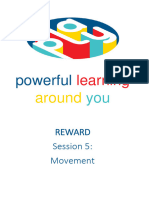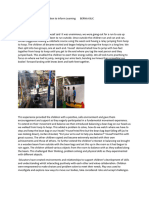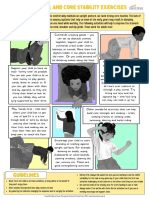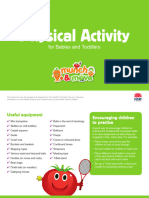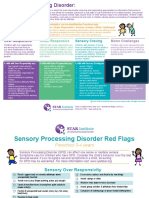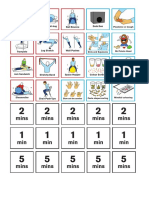Proprioceptive Activities: 301 Dogwood Street, Campbell River, B.C. V9W 2Y1
Proprioceptive Activities: 301 Dogwood Street, Campbell River, B.C. V9W 2Y1
Uploaded by
Damayanti ThapaCopyright:
Available Formats
Proprioceptive Activities: 301 Dogwood Street, Campbell River, B.C. V9W 2Y1
Proprioceptive Activities: 301 Dogwood Street, Campbell River, B.C. V9W 2Y1
Uploaded by
Damayanti ThapaOriginal Title
Copyright
Available Formats
Share this document
Did you find this document useful?
Is this content inappropriate?
Copyright:
Available Formats
Proprioceptive Activities: 301 Dogwood Street, Campbell River, B.C. V9W 2Y1
Proprioceptive Activities: 301 Dogwood Street, Campbell River, B.C. V9W 2Y1
Uploaded by
Damayanti ThapaCopyright:
Available Formats
Proprioceptive Activities
Your child gets information from their skin, muscles and joints that goes to their brains. This
proprioceptive information then goes to the muscles where they are ‘told’ what to do and then
to the rest of the brain where it combines with other information to figure out where the body
is and how it is moving. Below are activities that can help your child feel where their body is
in space, feel more grounded and have a calming effect. Proprioceptive activities have longer
lasting effects than other sensory strategies and can increase focus. They are also good for
developing better body awareness, thereby improving motor movements.
Activities to try:
Deep pressure to the body by giving big hugs, squishes, ‘sit’ on them, roll a ball over
their trunk/legs/arms
Use a therapy brush on arms, legs, trunk and back
Push, lift and carry heavy items (eg. move the furniture around the house, push heavy
laundry baskets, carry books)
Do wheelbarrow walking (hands on ground, feet held by adult)
Jump on a trampoline. If no trampoline, jump on ground.
Climb a steep hill
Pull a friend across the floor on a blanket
Rough house with another child or adult or pet (with
safety guidelines in place)
Climb on outdoor climber
Do obstacle courses; start with 3 requests and add as your child’s movements
become smoother and faster. Change and add requests to the obstacle course as
they improve. Example of obstacle course: jump up and down, run to the wall, roll on
the floor.
Activities involving the whole body, especially the arms are best
Many playground activities are very stimulating. Try to find games that need to be
done slow and require heavy work.
301 Dogwood Street, Campbell River, B.C. V9W 2Y1
Telephone: (250) 286-0955 • Fax: (250) 287-2676
Early Intervention Program – Occupational Therapy
You might also like
- Practical Life ActivitiesDocument83 pagesPractical Life ActivitiesAlina Constantin100% (6)
- Sensory Environment AssessmentDocument2 pagesSensory Environment AssessmentDamayanti Thapa100% (1)
- Proprioception for Children in School - ND ENGDocument3 pagesProprioception for Children in School - ND ENGElena BejenaruNo ratings yet
- 10 Easy Exercises For Kids: Boks Middle School Helps Them Do Better in SchoolDocument31 pages10 Easy Exercises For Kids: Boks Middle School Helps Them Do Better in SchoolMARIA REYNALYN MAGTIBAYNo ratings yet
- Uploads 2017-04-17 C3 S5 Movement RewardDocument11 pagesUploads 2017-04-17 C3 S5 Movement Rewardnontobeko.ndlovu456No ratings yet
- Sensory Processing Proprioceptive ActivitiesDocument4 pagesSensory Processing Proprioceptive Activitiesjemiah.coyoca.crsNo ratings yet
- CHCECE023 Outdoor 2 ANALYSE INFORMATION TO INFORM LEARNING BERNA KILICDocument2 pagesCHCECE023 Outdoor 2 ANALYSE INFORMATION TO INFORM LEARNING BERNA KILICBerna KilicNo ratings yet
- First Step 8Document3 pagesFirst Step 8markus_danusantosoNo ratings yet
- By: Xainab Rana DPT 2 YearDocument66 pagesBy: Xainab Rana DPT 2 Yearpicgraphy.16No ratings yet
- 12 Physical Activities For Toddlers and PreschoolersDocument15 pages12 Physical Activities For Toddlers and PreschoolersLovely Locsin VillarNo ratings yet
- CH 13 Sensation Always To PlayDocument51 pagesCH 13 Sensation Always To PlaySérgia FrançaNo ratings yet
- The Sensory Side Heavy Work Tip SheetDocument2 pagesThe Sensory Side Heavy Work Tip SheetPriyanka MishraNo ratings yet
- Cu TeDocument5 pagesCu Tehedchuganfarryl14No ratings yet
- Postural Control and Core Stability ExercisesDocument1 pagePostural Control and Core Stability ExercisesAMGNo ratings yet
- 7 Toe WalkingDocument5 pages7 Toe WalkingHuda JabeenNo ratings yet
- Organizing Alerting Calming Activities For Kids FINALDocument5 pagesOrganizing Alerting Calming Activities For Kids FINALLauraNo ratings yet
- G.Y.M. Night March 6 - April, Eleni, Emma, and JewelDocument3 pagesG.Y.M. Night March 6 - April, Eleni, Emma, and JewelgymoversNo ratings yet
- Summer Activities PacketDocument14 pagesSummer Activities PacketAlice DwyerNo ratings yet
- Sensory Diet 2Document2 pagesSensory Diet 2Pamm50% (2)
- Physical Activity Workshop Powerpoint Updated Dec 2011Document49 pagesPhysical Activity Workshop Powerpoint Updated Dec 2011dyah ayu shinta lesmanawatiNo ratings yet
- Moving Children To Good Health: Physical Activity For Young ChildrenDocument49 pagesMoving Children To Good Health: Physical Activity For Young Childrendyah ayu shinta lesmanawatiNo ratings yet
- Manipulating The EnvironmentDocument2 pagesManipulating The EnvironmentErica Rose OrcajadaNo ratings yet
- Sensory Integration Toe WalkingDocument2 pagesSensory Integration Toe WalkingHuda JabeenNo ratings yet
- DLP - MathDocument9 pagesDLP - MathEfren Gumindo Libuhan Jr.No ratings yet
- Things Move K-2 Unit GuideDocument9 pagesThings Move K-2 Unit GuideClaire ShallveyNo ratings yet
- Handout Domains DevDocument3 pagesHandout Domains DevJhonNo ratings yet
- Things Move k-2 Unit GuideDocument8 pagesThings Move k-2 Unit GuidepimbetttNo ratings yet
- PE and HEALTH - WEEK 7 - DAY2Document63 pagesPE and HEALTH - WEEK 7 - DAY2remil badolesNo ratings yet
- Fitness For Toddlers With Cystic FibrosisDocument1 pageFitness For Toddlers With Cystic FibrosishithisiseliNo ratings yet
- Overview of Sensory Breaks For Home and SchoolDocument7 pagesOverview of Sensory Breaks For Home and SchoolShah MansiNo ratings yet
- Discover Proprioception: A "Hidden" Sense©: by Zoe Mailloux, OTD, OTR/L, FAOTADocument2 pagesDiscover Proprioception: A "Hidden" Sense©: by Zoe Mailloux, OTD, OTR/L, FAOTAFlahiza MarquesNo ratings yet
- Mos Word 2016: (Document Subtitle)Document4 pagesMos Word 2016: (Document Subtitle)Thế Anh ĐoànNo ratings yet
- Sensory DifferencesDocument23 pagesSensory DifferencesNino PantsulaiaNo ratings yet
- Activity Plan For Physical DevelopmentDocument9 pagesActivity Plan For Physical DevelopmentprincessNo ratings yet
- Forceand Motion Lesson PlanDocument3 pagesForceand Motion Lesson Plansunkissed82No ratings yet
- Physical Development BDocument7 pagesPhysical Development Bchris black MateusNo ratings yet
- Proprioception After School, Evening, Bedtime 2Document2 pagesProprioception After School, Evening, Bedtime 2davison3No ratings yet
- Physcial Science Hand OutDocument4 pagesPhyscial Science Hand Outapi-408800981No ratings yet
- Sensory Processing Vestibular ResourcesDocument4 pagesSensory Processing Vestibular ResourcesDavid NkwabiNo ratings yet
- Week Six GYM NightsDocument7 pagesWeek Six GYM NightsgymoversNo ratings yet
- Gross Motor Skills: Children, Young People and Families Occupational Therapy TeamDocument12 pagesGross Motor Skills: Children, Young People and Families Occupational Therapy TeamDamayanti Thapa100% (2)
- Gymnastics Lesson PlanDocument13 pagesGymnastics Lesson PlanpraveenNo ratings yet
- Movement Games: Warm-Up Strength Development GamesDocument30 pagesMovement Games: Warm-Up Strength Development Gamesdelika12100% (1)
- Balance and Coordination in ECEDocument16 pagesBalance and Coordination in ECEFrancis kevin Parre�oNo ratings yet
- Effects of Force To The Size, Shape or Movement of An ObjectDocument19 pagesEffects of Force To The Size, Shape or Movement of An ObjectYen ZaraNo ratings yet
- Easy Sensory Diet Activities To Help Kids Focus On Homework - 3Document2 pagesEasy Sensory Diet Activities To Help Kids Focus On Homework - 3tutuianu.catalinNo ratings yet
- Physics For KidsDocument10 pagesPhysics For KidsmuwahNo ratings yet
- PE - Fun FitnessDocument6 pagesPE - Fun FitnessFardosNo ratings yet
- Families of ActionsDocument3 pagesFamilies of ActionsMerche EstalloNo ratings yet
- Bubble Wrap Gross Motor Skills ActivitiesDocument3 pagesBubble Wrap Gross Motor Skills ActivitiesNoreen GriffinNo ratings yet
- 10_exercises_to_boost_child_development_and_core_strength (1)Document2 pages10_exercises_to_boost_child_development_and_core_strength (1)afraadhayaniNo ratings yet
- Module 15 Preschoolers' Physical DevelopmentDocument29 pagesModule 15 Preschoolers' Physical DevelopmentAmy Apelado ApigoNo ratings yet
- Sensory Diet: SampleDocument14 pagesSensory Diet: SampleAyra MagpiliNo ratings yet
- PABabiesand ToddlersDocument12 pagesPABabiesand ToddlershaythamsamiNo ratings yet
- Read! Move! Learn!: Active Stories for Active LearningFrom EverandRead! Move! Learn!: Active Stories for Active LearningNo ratings yet
- G.Y.M Night Week TwoDocument3 pagesG.Y.M Night Week TwogymoversNo ratings yet
- Bringing It Home 1Document4 pagesBringing It Home 1Ana CarolinaNo ratings yet
- Carrying A ChairDocument2 pagesCarrying A Chairapi-734979884No ratings yet
- Early Childhood Measurement ToolDocument4 pagesEarly Childhood Measurement ToolDamayanti ThapaNo ratings yet
- Gross Motor Skills: Children, Young People and Families Occupational Therapy TeamDocument12 pagesGross Motor Skills: Children, Young People and Families Occupational Therapy TeamDamayanti Thapa100% (2)
- OT HOME PACKET - ComprehensiveDocument5 pagesOT HOME PACKET - ComprehensiveDamayanti ThapaNo ratings yet
- Activities To Improve Fine M Otor, Visual Motor & Visual Perceptual Skills at HomeDocument1 pageActivities To Improve Fine M Otor, Visual Motor & Visual Perceptual Skills at HomeDamayanti ThapaNo ratings yet
- Visual Motor Integration: Go To For The Complete DownloadDocument1 pageVisual Motor Integration: Go To For The Complete DownloadDamayanti ThapaNo ratings yet
- Preschool Sensory Resource - 0Document3 pagesPreschool Sensory Resource - 0Damayanti ThapaNo ratings yet
- Sensory Symptoms ChecklistDocument3 pagesSensory Symptoms ChecklistDamayanti ThapaNo ratings yet
- Sensory Integration Therapy Auditory Integration Training Ohp PDFDocument10 pagesSensory Integration Therapy Auditory Integration Training Ohp PDFDamayanti ThapaNo ratings yet
- The Money and Abundance PrayerDocument1 pageThe Money and Abundance PrayerNorthCarolinaNo ratings yet
- Developing Coordinated Hand Use Hand DominanceDocument2 pagesDeveloping Coordinated Hand Use Hand DominanceDamayanti ThapaNo ratings yet
- Determining A Student's Hand Dominance For Teachers: Materials NeededDocument1 pageDetermining A Student's Hand Dominance For Teachers: Materials NeededDamayanti ThapaNo ratings yet
- Occupational Therapy - Kids Health Information: Hand PreferenceDocument6 pagesOccupational Therapy - Kids Health Information: Hand PreferenceDamayanti ThapaNo ratings yet
- Tips For Sensory-ProcessingDocument6 pagesTips For Sensory-ProcessingDamayanti Thapa100% (1)
- Hand Dominance - Under 5's: The Following Is A List of Games and Activities To Help Develop Hand DominanceDocument1 pageHand Dominance - Under 5's: The Following Is A List of Games and Activities To Help Develop Hand DominanceDamayanti ThapaNo ratings yet
- Example: When I Come To The Chill Out Room I Will Do ThisDocument1 pageExample: When I Come To The Chill Out Room I Will Do ThisDamayanti ThapaNo ratings yet
- Mins Mins Mins Mins Mins: Dumbell Press Stability-Ball-Hug Ball Bounce Dark DenDocument1 pageMins Mins Mins Mins Mins: Dumbell Press Stability-Ball-Hug Ball Bounce Dark DenDamayanti ThapaNo ratings yet
- 9 I Need To LeaveDocument1 page9 I Need To LeaveDamayanti ThapaNo ratings yet
- Checklist For Pencil CaseDocument2 pagesChecklist For Pencil CaseDamayanti ThapaNo ratings yet





